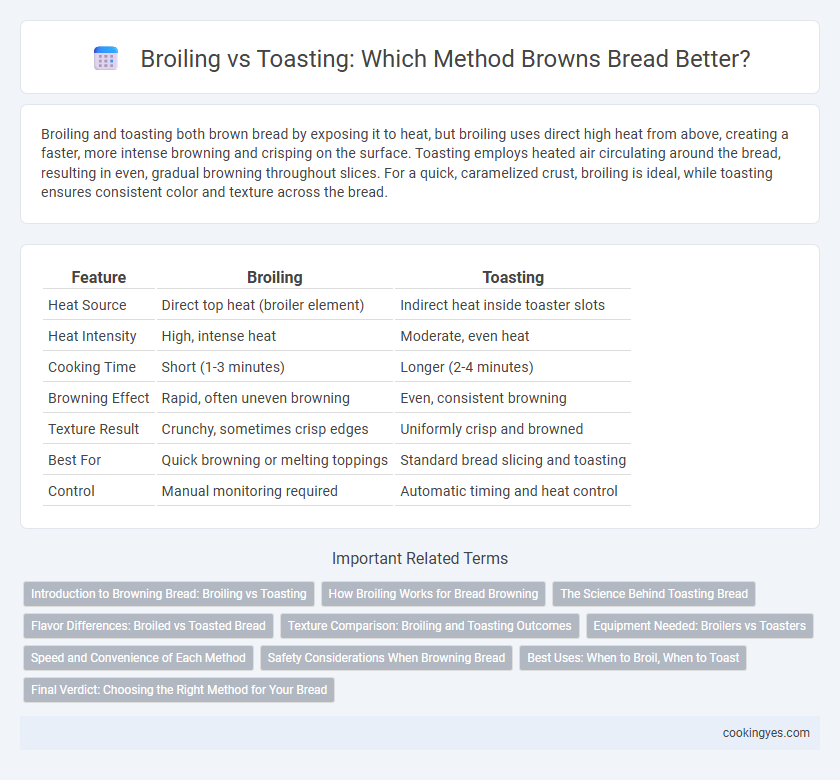Broiling and toasting both brown bread by exposing it to heat, but broiling uses direct high heat from above, creating a faster, more intense browning and crisping on the surface. Toasting employs heated air circulating around the bread, resulting in even, gradual browning throughout slices. For a quick, caramelized crust, broiling is ideal, while toasting ensures consistent color and texture across the bread.
Table of Comparison
| Feature | Broiling | Toasting |
|---|---|---|
| Heat Source | Direct top heat (broiler element) | Indirect heat inside toaster slots |
| Heat Intensity | High, intense heat | Moderate, even heat |
| Cooking Time | Short (1-3 minutes) | Longer (2-4 minutes) |
| Browning Effect | Rapid, often uneven browning | Even, consistent browning |
| Texture Result | Crunchy, sometimes crisp edges | Uniformly crisp and browned |
| Best For | Quick browning or melting toppings | Standard bread slicing and toasting |
| Control | Manual monitoring required | Automatic timing and heat control |
Introduction to Browning Bread: Broiling vs Toasting
Broiling uses high direct heat from above, rapidly browning the bread's surface and creating a crisp texture, while toasting employs even, low heat that evenly browns both sides of the bread. Broiling is ideal for quick caramelization and intense browning, whereas toasting provides uniform color and crunch. Selecting between broiling and toasting depends on the desired texture and browning intensity for the bread.
How Broiling Works for Bread Browning
Broiling uses intense, direct radiant heat from above to brown bread quickly, creating a crisp, caramelized surface. This high-temperature exposure triggers the Maillard reaction, enhancing flavor and color more rapidly than toasting. Due to the close proximity to the heating element, broiling requires careful attention to avoid burning while achieving optimal browning.
The Science Behind Toasting Bread
Broiling and toasting both brown bread through the Maillard reaction, a chemical process between amino acids and reducing sugars that forms complex flavors and golden-brown crusts. Broiling exposes bread to intense, direct radiant heat from above, quickly caramelizing the surface, while toasting evenly heats both sides with dry heat, allowing for uniform browning. Understanding the exact heat transfer and reaction times is key to achieving the perfect texture and flavor in browned bread.
Flavor Differences: Broiled vs Toasted Bread
Broiled bread develops a deeper, caramelized crust with complex, smoky notes due to intense direct heat, enhancing flavor intensity beyond typical toasting. Toasted bread offers a more uniform golden-brown surface with a mild, nutty aroma and crisp texture, preserving the bread's original taste profile. Choosing broiling or toasting affects flavor complexity, with broiling delivering a bold, slightly charred character while toasting maintains subtle, toasted grain flavors.
Texture Comparison: Broiling and Toasting Outcomes
Broiling bread produces a crisp, caramelized crust with a slightly softer interior due to intense direct heat, enhancing flavor complexity through Maillard reactions. Toasting evenly dries the bread, resulting in a uniformly crunchy texture throughout, ideal for maintaining structural integrity in sandwiches. Texture differences are key: broiled bread offers a contrast between crusty edges and tender crumb, while toasted bread provides consistent crunch from surface to center.
Equipment Needed: Broilers vs Toasters
Broilers require an oven with a broil setting that provides high, direct heat from above, often needing a broiler pan or oven rack for optimal bread browning. Toasters use electric heating elements inside a compact slot designed specifically for evenly browning bread surfaces. The equipment differences impact heat distribution and browning control, with broilers offering intense heat suitable for more variable results and toasters providing consistent, quick toasting.
Speed and Convenience of Each Method
Broiling browns bread quickly by exposing it to high heat from above, typically taking just 1-2 minutes, making it ideal for rapid toasting when time is limited. Toasting uses electric or toaster ovens that apply heat evenly to both sides, usually requiring 3-5 minutes but offering consistent browning and less active monitoring. For speed and convenience, broiling excels in quick batches, while traditional toasting provides hands-free operation and uniform results.
Safety Considerations When Browning Bread
Broiling bread exposes it to high heat from above, increasing the risk of burning and fire hazards, especially if left unattended. Toasting uses lower, more controlled heat, reducing the chance of uneven browning and sparks in standard kitchen appliances. Always monitor the bread closely during broiling and avoid placing flammable materials nearby to ensure safe browning.
Best Uses: When to Broil, When to Toast
Broiling is ideal for quickly browning the top of thicker bread slices or open-faced sandwiches, creating a crisp, caramelized crust without drying the interior. Toasting is best for evenly browning thinner slices of bread or bagels, providing a consistent crunch suitable for everyday breakfast or sandwich bases. Use broiling for intense, quick heat on one side and toasting for gradual, balanced heat on both sides.
Final Verdict: Choosing the Right Method for Your Bread
Broiling uses intense, direct heat from above to quickly brown bread, creating a crisp crust with a slightly charred finish, ideal for open-faced sandwiches or bruschetta. Toasting evenly heats bread from both sides, producing a uniform golden-brown color and crunchy texture, perfect for breakfast toast or sandwiches. Choosing between broiling and toasting depends on desired texture and appearance: broiling offers rapid, high-heat browning, while toasting delivers consistent, even crispness.
Broiling vs toasting for browning bread Infographic

 cookingyes.com
cookingyes.com